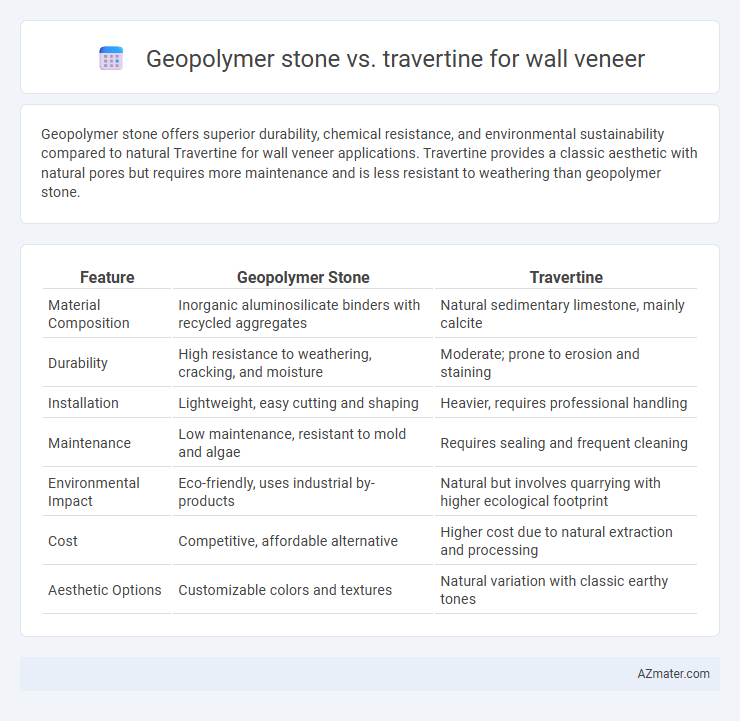Geopolymer stone offers superior durability, chemical resistance, and environmental sustainability compared to natural Travertine for wall veneer applications. Travertine provides a classic aesthetic with natural pores but requires more maintenance and is less resistant to weathering than geopolymer stone.
Table of Comparison
| Feature | Geopolymer Stone | Travertine |
|---|---|---|
| Material Composition | Inorganic aluminosilicate binders with recycled aggregates | Natural sedimentary limestone, mainly calcite |
| Durability | High resistance to weathering, cracking, and moisture | Moderate; prone to erosion and staining |
| Installation | Lightweight, easy cutting and shaping | Heavier, requires professional handling |
| Maintenance | Low maintenance, resistant to mold and algae | Requires sealing and frequent cleaning |
| Environmental Impact | Eco-friendly, uses industrial by-products | Natural but involves quarrying with higher ecological footprint |
| Cost | Competitive, affordable alternative | Higher cost due to natural extraction and processing |
| Aesthetic Options | Customizable colors and textures | Natural variation with classic earthy tones |
Introduction to Geopolymer Stone and Travertine
Geopolymer stone is an innovative, eco-friendly material made from industrial byproducts such as fly ash and slag, offering high durability and resistance to weathering. Travertine, a natural sedimentary stone formed from mineral deposits in hot springs, provides a distinctive porous texture and warm color palette ideal for wall veneers. Both materials offer unique aesthetic appeal and performance characteristics, with geopolymer stone excelling in sustainability and travertine prized for its classic natural beauty.
Composition and Formation
Geopolymer stone is an engineered material composed primarily of aluminosilicate minerals activated by alkaline solutions, forming a dense and durable binder through a chemical polymerization process at low temperatures. Travertine is a natural sedimentary rock composed mainly of calcium carbonate, formed through the rapid precipitation of minerals from groundwater in limestone caves or hot springs. The synthetic nature of geopolymer stone allows for greater uniformity and controlled porosity compared to the naturally porous and variable texture of travertine.
Aesthetic Differences
Geopolymer stone offers a contemporary aesthetic with customizable textures and colors, providing a sleek, uniform appearance ideal for modern designs. Travertine wall veneer features natural veining and porous textures, creating a rustic charm with warm earth tones that evoke traditional elegance. The distinct visual contrast lies in geopolymer's engineered consistency versus travertine's organic, unique patterns that enhance architectural character.
Durability and Longevity
Geopolymer stone exhibits superior durability and resistance to weathering compared to natural travertine, making it a reliable choice for wall veneer in harsh environments. Its engineered composition offers enhanced longevity by resisting cracks, stains, and erosion better than porous travertine surfaces. This longevity reduces maintenance costs and extends the aesthetic appeal of exterior and interior facades.
Environmental Impact
Geopolymer stone offers a significantly lower environmental impact compared to travertine for wall veneer applications due to its use of industrial by-products like fly ash, reducing reliance on natural quarrying and minimizing carbon emissions. Travertine extraction involves extensive mining processes that contribute to habitat disruption and higher energy consumption. Choosing geopolymer stone helps promote sustainable construction practices by decreasing resource depletion and reducing overall carbon footprint.
Installation Process and Requirements
Geopolymer stone wall veneer installation requires precise mixing of synthetic materials and molds for curing, resulting in lightweight, durable panels that are easier to handle and fix. Travertine wall veneer demands skilled cutting and fitting of natural stone slabs, often needing additional reinforcement or waterproofing due to its porous nature. While geopolymer stone can be installed with standard masonry adhesives on various substrates, travertine may require specialized mortar and sealing treatments to ensure long-term stability and resistance to moisture.
Cost Comparison
Geopolymer stone offers a cost-effective alternative to travertine for wall veneer, with prices typically ranging from $15 to $30 per square foot compared to travertine's $25 to $50 per square foot. Installation costs for geopolymer stone are generally lower due to its lighter weight and uniform size, which reduce labor time and complexity. Long-term maintenance expenses also favor geopolymer stone, as it resists staining and weathering better than porous travertine, lowering overall lifecycle costs.
Maintenance and Upkeep
Geopolymer stone requires minimal maintenance due to its high resistance to stains, moisture, and weathering, making it ideal for long-term wall veneer applications. Travertine, being a natural stone, demands regular sealing and careful cleaning to prevent damage from acidic substances and water infiltration. The durability and low upkeep of geopolymer stone often result in lower overall maintenance costs compared to the more porous and maintenance-intensive travertine veneer.
Suitability for Indoor and Outdoor Applications
Geopolymer stone offers exceptional durability, high resistance to weathering, and low porosity, making it highly suitable for both indoor and outdoor wall veneer applications. Travertine, while aesthetically pleasing with its natural texture and warm tones, is more porous and requires sealing to prevent damage from moisture and staining, limiting its long-term outdoor suitability. For outdoor projects exposed to harsh environmental conditions, geopolymer stone provides superior structural integrity and maintenance ease compared to travertine.
Final Recommendations for Wall Veneer Choices
Geopolymer stone offers superior durability, resistance to moisture, and eco-friendly properties compared to natural travertine, making it ideal for exterior wall veneers in harsh climates. Travertine provides authentic natural stone aesthetics and breathability but requires more maintenance and is prone to staining and weathering over time. Final recommendations favor geopolymer stone for long-term performance and sustainability, while travertine suits projects prioritizing classic elegance and natural texture with moderate upkeep.

Infographic: Geopolymer stone vs Travertine for Wall veneer
 azmater.com
azmater.com